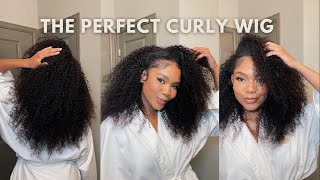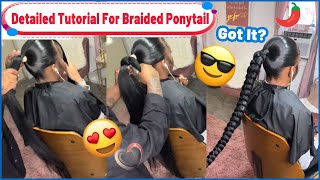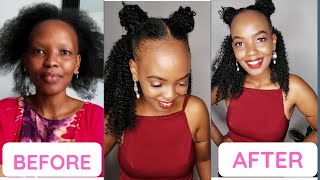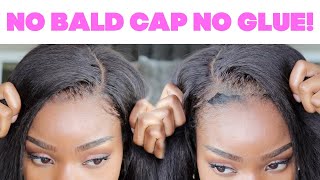Ready To Take Down Your Long Term Protective Style? What You Should Do During And After Take Down

It’s time – you have to face the music. You cannot go another weekend. It is time to remove that protective style. Whether you have Box Braids, Senegalese Twists, a Sew-In, or any other protective styles, you knew that eventually there would be a removal process. It’s inevitable, unless you have faux dreads, and decide to grow your hair with it.
Moreover, when you have worn your braids in an “I don’t care bun” for a week straight, or your sew-in is hanging on by a thread, then you know it is time to take your style out.
Depending on the style you have installed, your long term style should be worn from 6 to 12 weeks. Anything over that is detrimental to your hair, causing possible tangles, matting, and even overgrowth with the weave*. Not cute!
Although you can go back to your stylist or braider to have your style removed, you can also opt to take your style out yourself. Personally, I would rather save my $40 for removal by my stylist, and take out my own hair.
I have some steps that you can follow for an easy, stress free removal and pampering process of a few styles: sew-in, crochet braids, and all other braids (Senegalese Twists, Box Braids, Kinky* Twists, etc.).
I recommend making this a two day removal process, but you can choose to do all of this in one day. Taking out your extensions* could take an hour or so; in the meantime, put on your favorite show, talk to a friend, or listen to some music.
Take out process for common protective styles
Crochet Braids
With this style your hair is cornrowed back, or in a spiral pattern with your extensions woven in the braids by a latch hook. To remove your crochet braids, all you have to do is cut the knots of your extensions.
Once all of the extensions* have been cut out, carefully pull the cut-knot from your braids. Now that your extensions have been removed completely, take your time to unravel your braids.

Sew-in
With this style, your hair is braided to your scalp with your extension sewn in the braid. To make this removal process easy for you, work by the rows that were braided to your scalp. Separate the first row on your nape, and clip the rest of the hair away.
Carefully take your hair shears, and take your time cutting the thread in the braid very slowly, being very careful not to cut your own hair. Once all the thread is cut, gently pull that track away from your hair. Once all of the extensions are removed from your head, carefully unbraid your own hair.
Braid Extensions
With this style, your own hair is entwined with extensions for your Senegalese Twists, Box Braids, Kinky* Twists, and others. To remove your braids, have a detangling spritz, spray bottle with water and conditioner, or oil in a spray bottle ready in order to make your braids slippery for an easy take out process.
If you are comfortable with cutting your braids, cut one inch below where you know your natural hair is; this will save you many hours in removing your braids. If not, or you do not know where your natural hair stops, cut two inches from the bottom of your braids. This will take longer, but you will know that your own hair won’t be cut by uncertainty.
Slowly and carefully, begin to unravel your extensions*. If you come across a snag or a knot, do not tug or force the braid to come lose; this will only cause harm to your own hair. Just add more of the product you are using for some more slip, and continue to unravel the braid.
Wash Day Process
Detangle
Once your hair is free of your extensions*, section your hair in medium-sized sections; I usually have 6 (two on the top, two in the middle, and two in the back). Apply and massage conditioner and/or oil to your tresses, then clip each section away. Let this sit on your hair for a few minutes in order to saturate in the hair, and to prepare for the detangling process.
 Once the conditioner and/or oil have had some time to sit on your hair, carefully begin to detangle your hair. Don’t be alarmed if you a lot of shed hair during this process, this is normal.
Once the conditioner and/or oil have had some time to sit on your hair, carefully begin to detangle your hair. Don’t be alarmed if you a lot of shed hair during this process, this is normal.
There will be lint and knots throughout your hair, so be sure to take your time, and be extremely careful during this process. You can use a wide-tooth comb, or your fingers for this process. Make sure to remove all the shed hair, lint, and pieces of extensions* as much as you can. If not, your hair will become tangled and matted during your washing process.
Washing
We suggest using a clarifying shampoo* instead of a regular or moisturizing shampoo, so your hair can be squeaky clean from shed hair, and any pieces of extensions left in your hair.
Additionally, since your hair was in the long term style, you want to remove any debris and build up from the products that were used to maintain the style as well. You can also opt to do a pre-poo or hot oil treatment, before you wash your hair to ensure that your hair won’t be too stripped of moisture.
Protein Treatment
Protein treatments after long term styles are a must! Because your hair has been in a long term style, your hair strands are weak, and using a protein treatment in your washing regimen will strengthen your hair strands.
Deep Conditioning
After your protein treatment, you will need to do a moisture based deep conditioning* treatment. Whether you use your own concoction or a commercial product, deep conditioning* will bring a great amount of moisture back in your hair. Using a plastic cap under a hooded dryer* for at least 30 to 45 minutes will be beneficial to your hair, as well.
What to do now
It is important to give your hair some time to breathe once your extensions* are removed. Your hair needs at least one to two weeks to regain the proper moisture balance and its strength from your long term style. Once your hair is healthy and strong again, then you can get your next install.




